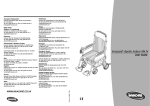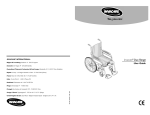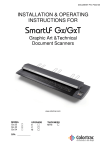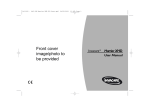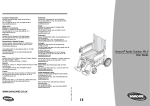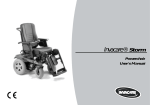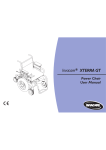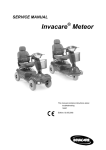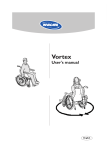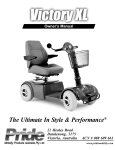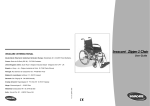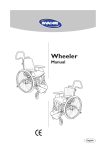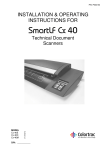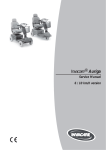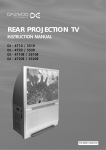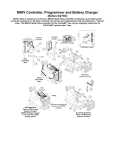Download Apollo Indoor MkIV UG 0102.qxd
Transcript
InvacareR Apollo Indoor Mk.IV User Guide INVACARE®INTERNATIONAL: Belgium & Luxemburg: Autobaan 14 · B-8210 Loppem Danmark: Sdr. Ringvej 39 · DK-2605 Brøndby Deutschland, Österreich, Switzerland & East Europe: Dehmer Straße 66 · D-32549 Bad Oeynhausen España: c/ Areny · s/n Polígon Industrial de Celrà · E-17460 Celrà (Girona) France: Les Roches · F-37230 Fondettes Italia: Via dei Pini 62 · I-36016 Thiene (VI) Nederland: Celsiusstraat 46 · NL-6716 BZ Ede Norge: Grensesvingen 9 · N-0603 Oslo Sverige & Suomi: Fagerstagatan 9 · P.O. Box 66 · S-163 91 Spånga United Kingdom & Eire: South Road · Bridgend Industrial Estate · Bridgend CF31 3PY · UK Part No: 1416069 - GB - 0104 Portugal: Rua Senhora de Campanhã 105 · P-4369-001 Porto Apollo Indoor MkIV UG 0104.qxd 10/01/2004 Page 1 Apollo Indoor Mk.IV User Manual INTRODUCTION Thank you for choosing an Apollo Indoor Mk.IV Powerchair - we are certain that you will be delighted with it. Just to make doubly sure you really gain the full benefits from your remarkable new INVACARE Powerchair and to ensure many years of trouble free performance, this manual gives you essential information concerning Safety, Handling and Operation, together with some helpful tips. Please read it carefully before trying out your new Apollo Indoor Mk.IV, so that you may truly enjoy your new independence. We recommend to have your Powerchair inspected and serviced by an authorised INVACARE dealer at least once a year. It is in your best interests, not only to ensure your personal safety, but also the continued high performance and long service life of your Powerchair. Whenever you need special advice and assistance, or if there is any problem with your Powerchair, do not hesitate to contact the local INVACARE dealer. He is just a phone call away and has all the equipment and knowhow required to provide you with expert professional service. IMPORTANT Your Apollo Indoor Mk.IV is equipped with the most advanced electronic control system which is fully programmable to suit a wide variety of user preferences. More details later in this manual. However, if you feel, after an initial running-in period that certain characteristics of the Powerchair performance and response require adjustment to customise it in accordance with your particular needs and conditions (e.g. acceleration, braking, damping and general response to joystick movements, etc.), contact your local INVACARE dealer who will advise you and carry out any "tuning" required. The Apollo Indoor chair is primarily designed for use Indoors, however, Invacare are aware that some users do occasionally take their chairs outdoors. If this is the case, Invacare recommend that the user must ensure that ant-tippers are fitted at all times. Invacare will not accept any liability from any claims that may arise as a result of the chair being used in an outdoor environment. If you have any questions regarding the suitability of this chair, please contact your Invacare representative. 1 Apollo Indoor MkIV UG 0203.qxd 18/02/2003 13:58 Page 2 CONTENTS YOUR LEGAL AND GENERAL RESPONSIBILITIES DESCRIPTION STANDARD FEATURES Automatic Fail-Safe Brakes Opening and Folding the Wheelchair Folding Backrest Detachable Armrest Adjustable/Detachable Footrest Gel Batteries OPTIONAL FEATURES Backrest Extension Adjustable Armrest Cushions Detachable Elevating Legrest Anti-Tipping Kit SAFETY PRECAUTIONS/SAFE OPERATION Safety indoors Some Useful Tips Stability and Balance Driving on Level Ground Negotiating Gradients/Slopes Negotiating Kerbs PREPARING YOUR POWERCHAIR READY FOR USE Unfolding Folding/Dismantling Footplate Height/Angle Accessories Including Lap Belt Adjustment CONTROLS AND OPERATING YOUR POWERCHAIR Operation Drive Mechanism Freewheel Operation Driving Practice Transferring to and from your Powerchair ROUTINE MAINTENANCE AND GENERAL CARE Tyres Control Box and Power Module Cleaning Batteries & Battery Charging Batteries When to Charge Charging Procedure PERIODIC MAINTENANCE TROUBLESHOOTING TRANSPORTATION 15 TECHNICAL SPECIFICATION WARRANTY HOW TO CONTACT INVACARE 2 3 3 4 4 4 4 4 5 5 5 5 5 5 5 5 6 6 7 7 7 8 8 8 8 9 10 10 10 10 10 10 11 11 11 11 11 12 12 12 13 13 14 15 17 18 Back Cover Apollo Indoor MkIV UG 0203.qxd 18/02/2003 13:58 Page 3 YOUR LEGAL AND GENERAL RESPONSIBILITIES As a Powerchair user you must be aware of the risks involved to both yourself and others. However, what is the position if you are involved in an accident and damage the property of a third party, or worse, run into somebody and cause injuries? Many Powerchair users do not realise that they may be held liable in such cases. We strongly recommend that you take out “Third-Party Liability” Insurance to cover you against any possible claims from that direction. If you already have some other insurance policy, ask these insurers what they can offer you for such cover. Alternatively, ask your INVACARE dealer who will be able to advise you. In this way you buy yourself not only protection against possible costs, but also peace of mind. You are also responsible to ensure your Apollo Indoor Mk.IV is in a ‘good working order’ at all times. DESCRIPTION Manufactured to the highest possible standards your new Apollo Indoor Mk.IV Powerchair has been designed with the emphasis on safety, comfort and reliability for use by those with restricted mobility. The Apollo Indoor Mk.IV has a maximum carrying capacity of 20 stone (127kg) which must never be exceeded. 1 2 8 3 7 4 Fig. 1. Apollo Mk.IV - General Features 1. Pram Handle Bar - Removable 2. Backrest - Folding 3. Armrests - Detachable 4. Motor/Gearbox Drive Unit 5. Manual Wheel Locks (Parking Brakes) 6. Footrests - Swingaway, Adjustable Height/Angle, Removable 7. Seat Assembly 8. Joystick Control Box - Variable Position 5 6 3 Apollo Indoor MkIV UG 0104.qxd 10/01/2004 Page 4 STANDARD FEATURES A number of standard features are available on the Apollo Wheelchair. These include: 1. 2. 3. 4. 5. Automatic fail-safe brakes Folding for storage Folding backrest Detachable armrests Adjustable/Detachable footrests Automatic fail-safe brakes The brakes activate automatically when the chair is stationary and power is on. Parking brakes are hand operated. Each wheelchair has a separate left and right hand brakes acting upon the rear wheels. NOTE The parking brakes should be applied to both wheels whenever the wheelchair is stationary and power is off. PULL PULL Opening and folding the wheelchair To open the chair - grasp the padded armrest tops and pull outwards until there is sufficient room to push down the sides of the seat canvas. Before the chair is fully open, detach one side of the canvas, position the batteries and battery cradle, then replace the canvas. PUSH To close the chair - detach the seat canvas, remove the batteries and replace canvas. Grasp the seat canvas tubes at the front corner of the canvas and pull upwards until the chair is part closed then push the armrests together. Folding backrest To fold the backrest - of the wheelchair stand behind and simultaneously raise the levers situated at each side of the backrest frame upright. With the levers fully up, the backrest is free to fold at the hinge. To raise the backrest - simply lift until it is upright and check that the levers have automatically dropped down into the locked position. Detachable armrest The armrests can be removed for storage and sideways transfer from the chair. To remove the armrests - rotate the armrest release lever (projecting outwards under the front of each armrest) upwards and at the same time lift the armrest out of the sockets. NOTE Before removing the armrest that has the control box fitted to it, the 9 pin plug must be disconnected. To replace the armrest - align the front and rear armrest tubes with their respective sockets and press down on the front of the armrest until the release lever locks firmly into place. 4 Apollo Indoor MkIV UG 0203.qxd 18/02/2003 13:59 Page 5 Adjustable/Detachable footrest To adjust the seat to footrest height - release the locking bolt with the spanner, set the correct height then re-tighten the bolt. The footplates - can be flipped up from a horizontal position to vertical to allow feet access to the ground. To swing the footrest assembly from its position at the front of the wheelchair to the side, pull back the locking catch to release the locking mechanism. While the footrest is in folded position it can also be detached by lifting the hinge brackets off the locating pins. When the footrest is swung back to its forward position the locking mechanism operates automatically, and the footrest can no longer be detached. The wheelchair should not be in motion unless the swinger and footplate assembly is in the correct position (not swung to the side of the chair). Gel batteries The two batteries are contained in individual plastic containers. The containers rest on a metal carrier located beneath the seat of the wheelchair. To position the batteries in the chair - lift the right hand side of the seat canvas, drop the carrier into position from the top position the batteries beside each other, making sure the reset switches are positioned to the back with the reset buttons pointing to the side. Connect both batteries into the wiring loom (black and red connectors). OPTIONAL FEATURES The following optional features are available: 1. 2. 3. 4. 5 Detachable backrest extension Adjustable armrests Cushions Detachable elevating legrests Anti-tipping kit Backrest extension For user requiring behind the head, a detachable extension unit can be attached. Adjustable armrest Gives height adjustments and allows the control box to be moved fore and aft. Cushions Seat and back cushions, constructed from flame retardant foam and covered in canvas backed PVC material, can be provided for comfort. NOTE The users own cushions, catering for more specialised needs (i.e. pressure sore prevention), can be placed in the wheelchair. Detachable elevating legrest If standard footrests are not able to be adequately support the feet a more adjustable unit can be fitted. The optional unit has all the features of the standard footrest with the addition of angular adjustments. Anti-tipping kit Anti-tipping kit must be fitted by qualified technicians. 5 Apollo Indoor MkIV UG 0104.qxd 10/01/2004 Page 6 SAFETY PRECAUTIONS/SAFE OPERATION IMPORTANT WARNING The day-to-day activities and the more advanced Powerchair techniques depend, on your physical capabilities and your own specific circumstances. Our recommendations may occasionally differ from those of your Therapeutic Adviser or Physician, as they have a better understanding of your abilities. Where this is the case, you MUST FOLLOW THEIR advice, they are better placed to tell you what is suitable for you and what is not. DO NOT use your Powerchair when your driving ability is impaired by medication. Your Powerchair operating system may be influenced by electromagnetic fields such as signals emitted by portable telephones and other similar devices. It is strongly recommended that you switch off your Powerchair whilst in the vicinity of such devices. If your Powerchair is effected by these signals, immediately switch off the power by depressing the On/Off switch. CAUTION Always steer clear of obstacles where possible, ensure your clothing and hands are kept clear of all moving parts, ask for assistance when descending or ascending steep gradients. Never attempt to negotiate stairs. Never use an escalator to move a Powerchair between floors. Due to both the weight of a Powerchair and its occupant it is not advisable to attempt to be assisted up and down stairs whilst the Powerchair is occupied. Braking of your Powerchair is dependent on electromagnetic motor brakes. When these are disengaged by declutching the motor gear box drive system, the chair is in FREEWHEEL MODE, this mode is for EMERGENCY USE only and motor gear boxes should remain engaged at all other times. To avoid the Powerchair freewheeling, special care must be taken to either apply parking brakes where fitted or re-engage motor brakes. Safety Indoors When using your Powerchair indoors always consider the following potential hazards: Beware of the fact that many of the premises where you are likely to use your Powerchair may not have been designed with this consideration in mind. You should therefore have an awareness for safety when encountering the likes of narrow doorways, steps, high surfaces, protruding wall fittings and every day household items such as children’s toys, electrical appliances etc. Take extra care in kitchen environments. Consider the fire evacuation procedures for buildings you may be entering. Never put yourself at risk and ensure that you can be easily evacuated in the event of an emergency. NOTE Powerchairs drive very quietly, generally travel faster than the average walking pace and are low to the ground. Always consider these factors when using your Powered Wheelchair. 6 Apollo Indoor MkIV UG 0203.qxd 18/02/2003 13:59 Page 7 Some Useful Tips Before you venture off on your first journey, ensure that everything is adjusted to your specific needs, read this Manual to familiarise yourself with the product and its functions. DO NOT attempt to drive without attendant on hand until you are fully proficient in using and manoeuvring your Powerchair. Ensure power is switched off before entering or leaving your Powerchair. Before switching on, check that both motors are engaged, tyres are inflated to the correct pressure and are in good condition. When on the move DO NOT attempt turns at full speed, especially while travelling downhill. Before changing from forward to reverse, and vice versa, you must stop, failure to do so will cause severe damage to the electronics. DO NOT use your Powerchair beyond it’s limitations. Due to both the weight of a Powered Wheelchair and it’s occupant it is not advisable to attempt to be assisted up and down stairs whilst seated. When entering or leaving your Powerchair, DO NOT stand on the footplates. If you have to brake in an emergency, release the joystick. DO NOT switch off power while the Powerchair is moving, it would cause an abrupt, sharp stop. Before you change the Drive Mode (UP or DOWN) we advise you to stop the Powerchair in order to avoid a sudden leap forward when selecting a higher level programme, or an abrupt deceleration when changing to a lower level programme. DO NOT use your Powerchair beyond the limitations set out in this manual concerning kerb height, gradients, etc. Stability and Balance To ensure stability and safe control of your Powerchair you must at all times maintain proper balance. The Powerchair is designed to remain stable and upright during normal use, so long as you do not move your centre of gravity outside the normal seating position. Reaching - Bending Forward Ensure power is OFF. DO NOT lean forward your body out of the Powerchair further than the length of the armrests. DO NOT attempt to pick up objects from the floor by bending forward and reaching between your knees. DO NOT attempt to reach objects by sliding forward to the edge of the Powerchair seat. Reaching - Bending Backwards Again ensure power is switched OFF. DO NOT reach back any further than your arm will extend without changing your sitting position. DO NOT lean over the top of the backrest as it will shift the centre of gravity, risking tipping over. DO NOT hang heavy loads or objects on the backrest. They may make the Powerchair unstable, especially on an incline. Driving on Level Ground Try to get the “feel” of the Powerchair controls in a safe, level environment. If you are not satisfied with the response of the joystick (or whatever control devices fitted), contact INVACARE’S Recommended Service Centre and they will be able to re-programme the controller to your individual needs. 7 Apollo Indoor MkIV UG 0203.qxd 18/02/2003 13:59 Page 8 Negotiating Gradients/Slopes CAUTION Your Powerchair can safely climb gradients of 10º or a ratio 1: 6. DO NOT attempt to climb or descend slopes that are in excess of these figures, fit anti-tipping levers (Fig. 2) for slopes and outdoor use. If you are in a situation where by the Powerchair fails to climb a ramp and stalls midway through the manoeuvre, DO NOT attempt to turn the Powerchair to drive back down in a forward facing direction, always reverse slowly in a steady, flowing action and DO NOT brake harshly, as this will upset balance in this situation. If possible, always seek the assistance of an attendant. Fig. 2 PREPARING YOUR POWERCHAIR READY FOR USE Unfolding CAUTION When unfolding and folding your Powerchair take care to ensure that your hands or fingers are not positioned between moving parts and therefore likely to become trapped. Whether it is delivered to your home or you brought it back in the boot of your own car, your Powerchair will have arrived folded with the footrests (or elevating legrests) separated. If it has a reclining backrest, the headrest extension will also be detached. In this case push the tubes of the headrest extension firmly and squarely into the backrest tubes before you unfold the Powerchair. It is easier to do this first, before the backrest is opened and stretched. A demonstration showing assembly procedures relating to the correct installation of Batteries, Battery Cradle, Joystick Control Box and the connection of the Wiring Harness will have been carried out by your INVACARE supplier/dealer prior to delivery/collection, if you experience difficulties during assembly, DO NOT hesitate to contact your dealer who will be pleased to assist you. You can carry out the following steps standing up or seated, whichever is more comfortable to you. 1. 2. 3. 4. 5. 6. 8 Manoeuvre the Powerchair into a position, so that you are facing one side of it and that both wheel locks are applied. Tilt the Powerchair towards you. Rear wheel and Fig. 3 castor on the side away from you are slightly lifted off the floor. Press down on the seat side tube furthest from you and the Powerchair will smoothly unfold. Fit Armrests, Footrests and Joystick Box assemblies. Install Batteries/Cradle, ensure the Cradle is correctly located on the Tubes and fit Cradle Clamp with thumb screws (Fig.3), Strap down batteries by following the procedure described here: Separate the battery hold down strap into two halves by unclipping the buckle. Wrap around each velcroed end of both halves of the strap to the battery carrier and push velcro hooks and loops together to secure both halves of the hold down strap to the battery carrier as in Fig 4a. (strap adjusters facing downwards). Apollo Indoor MkIV UG 0203.qxd 7. 18/02/2003 Take care when lifting Batteries. To avoid injury be sure to adopt the correct lifting posture, ask for assistance if required. Lift both batteries into the battery carrier with the connecting leads towards the rear of the chair and push the batteries together into the centre of the carrier as in Fig 4b. Tension both halves of the strap so that when the buckles are clipped together, the batteries are held firm in the battery carrier Fig 4b. 8. Connect Harness and Cables. 9. Check all components are located correctly and fasteners are securely tightened. 10. Check the operation of all components and ensure they function correctly. 13:59 Page 9 Fig 4a Fig 4b Folding/Dismantling For ease of storage and transportation your Powerchair has been designed to dismantle into easily manageable components, remember, when lifting to adopt the correct posture, knees bent back straight, ask for help if you cannot manage the heavier components. 1. 2. 3. 4. 5. 6. 7. 8. Switch off power on the Joystick Box. If a Spreader bar is fitted across the backrest, detach it from the Backrest, also remove the kerb rider (if fitted). Check the footrests/legrests are in a locked position towards the front of the chair and that the footplates are folded upward to vertical position. Alternatively, remove the footrests/legrests from the Powerchair. To remove the footrest, press the lever behind the vertical chassis tube swing the footrest outward and unhook it from the frame. To install the footrest, hold it slightly angled away from the Powerchair, with the two hinge plates above the mounting pins on the Powerchair frame, align the holes in the hinge plates with the mounting pins, so that you can slide the hinge plates over the pins. Swing the footrest forward to its normal position until it snaps into lock. Disconnect all cables from the underside of the Electronic Power Module and the Battery connecting cables. Remove both Armrests along with the Joystick Box assembly. To remove the armrest, proceed in the same manner and simply pull it out of its mounting socket, altogether. On the side where the joystick box is fitted (usually on the right) the connecting cable from the joystick box to the underside of the electronic power module is long enough, so that this armrest can be removed in the same manner, place by the side of the Powerchair, alternatively, disconnect the joystick box cable from the power module. Remove thumbscrews and Cradle Clamp and Battery Straps. Remove the Batteries and Cradle. Take care when lifting Batteries. To avoid injury be sure to adopt the correct lifting posture, ask for assistance if required. With a firm grip pull both side tubes of the seat upward. The two Powerchair halves will concertina together and reduce the Powerchair to a compact stowage size. NOTE If your Powerchair is stowed or transported in a horizontal position, place it with the side of the power module and the joystick box uppermost, in order to avoid any damage. 9 Apollo Indoor MkIV UG 0203.qxd 18/02/2003 13:59 Page 10 Footplate Height/Angle As tools are required, adjustments to suit your needs should only be made by your INVACARE supplier/dealer prior to delivery/collection. If adjustments are required at a later date contact your dealer who would be pleased to assist you. Accessories Including Lap Belt Attachment These will have been factory fitted or by your INVACARE supplier/dealer, who would have provided you with a demonstration of operation and fitting etc. CONTROLS AND OPERATING YOUR POWERCHAIR For detailed description of joystick operation, refer to the Operating Manual supplied with the joystick. NOTE Before you start using your Powerchair you must boost the battery charge by carrying out charging procedures as described in "Battery Charging" and always check the following: 1. 2. 3. 4. Drive Mechanism couplings and Freewheel is engaged in drive Position (Fig. 5) and Parking locks (Manual) are released. Adjustments have been made to suit your individual needs and fasteners securely tightened. Tyres are in good condition. Check the operation of all controls and that they function correctly. Operation The Control Box can be fitted to either the right or left hand standard Armrest or as an option a detachable Adjustable Armrest is available to give further adjustments of the Armrest and Controller. Contact your INVACARE supplier/dealer. The Joystick mounted on top of the Control Box and the movement of the Joystick determines the direction that the chair will travel (i.e. forward movement of the Powerchair is achieved by pushing the Joystick forward and likewise for movement to the left, right and backward directions). When the Joystick is released, it automatically returns to a neutral position, triggering the automatic brake function and bringing the Powerchair to a immediate stop. Consult the Controller User Guide, provided for further information or Contact INVACARE supplier/dealer or your prescriber. The speed of the Powerchair is controlled via a Rotary Switch located at the back of the Control Box. Drive Mechanism The Powerchair is fitted with two 24V motors that drive the rear wheels. The drive mechanism couplings can be disconnected by grasping the lip (1) at the centre of the rear wheels, pulling outwards and twisting through 90°. The Powerchair will then freewheel and is able to be pushed by an attendant. Freewheel Operation Fig. 5 To push the Powerchair by hand in the event of a fault or battery failure, or simply to move it WITH NO OCCUPANT in it, the two motor/gearbox units can be declutched from the rear wheels. First ensure that power is switched OFF on the joystick box. Then, repeat the procedure described in the Drive Mechanism paragraph, above. To restore powered drive, turn BOTH lips back to their normal position. 10 1 Apollo Indoor MkIV UG 0203.qxd 18/02/2003 13:59 Page 11 CAUTION Freewheel operation is only intended for short-term use in SPECIAL CIRCUMSTANCES, NOT as a regular or permanent mode of Powerchair movement. In freewheel mode the Powerchair is NOT secured by the electromagnetic brakes, as both brake systems are out of action during this time. Before you attempt to drive the Powerchair again, ensure that both drive couplings are fully engaged. Driving Practice Release the manual brake. With the joystick you now control movement and direction of the Powerchair. To reverse, pull the joystick backward. By moving the joystick left or right (while the Powerchair is moving forward or backward) you steer the Powerchair. Push the joystick full left or right, and the Powerchair will turn around within its smallest turning circle. To slow down, guide the joystick towards its centre (neutral) position. If you have to stop in an emergency, simply release the joystick. It will automatically snap back to neutral and the Powerchair will come to a smooth halt. As a last resort ONLY press the On/Off switch which will serve as an emergency off switch. Once at a standstill, the Powerchair is instantly locked by the electromagnetic parking brakes, so that it is perfectly safe while it is stationary, even on an incline. Transferring to and from your Powerchair Circumstances and individual needs will vary from person to person, we advise you consult your Therapeutic Adviser who will help to advise and develop your skills for the appropriate transfer methods to suit your individual requirements. DO NOT attempt transferring unaided until you are confident and proficient in the skills to do so, remember always during transfer make sure the brakes are in the locked position and the Powerchair is manouvered as close as possible to the transfer seat and switched off. ROUTINE MAINTENANCE AND GENERAL CARE Your Powerchair is perhaps the one piece of equipment which gives you freedom and mobility, therefore it is important to look after it. Your Powerchair comprises of sophisticated electronic control systems and electrically operated parts, which should be checked and adjusted at regular intervals. Some of these checks you can, and should, carry out yourself, such as effective functioning of parking brake, tyres etc. There are procedures which demand more expertise, we therefore strongly advise you to have your Powerchair inspected and serviced by your local INVACARE supplier/dealer at least once a year. It will save you money in the long term, because certain minor irregularities or faults that are detected at an early stage before they develop into some major and more costly repairs. Tyres Check the tyres for excessive wear and possible damage (cracks, etc.). Check that solid tyres are firmly seated on the wheel rim (not loose) and free of damage. Excessively worn or damaged tyres should be replaced without delay. Control Box and Power Module Control Box and Power Module are in a splashproof enclosure, they should not be subjected to direct spillage of liquids (tipped over glasses, etc.). If spillage does occur, switch off power and dry the affected surfaces with an absorbent cloth. Do not expose the joystick box or the power module to excessive heat at close range (electric fire, hot air blower, etc.). To clean the joystick box and power module wipe the surfaces with a lint free cloth dampened with warm water or alcohol. DO NOT USE SOLVENTS. NOTE The indicator light in the ON/OFF switch may also begin to flash in certain other situations, because it also functions as a fault indicator in the event of any failure in the electric and/or electronic system of the Powerchair. For details, refer to the TROUBLESHOOTING in the joystick Operation Manual supplied with your Joystick. Check the joystick rubber gaiter and keypad are in good condition and show no signs of cracks, pin holes, etc. 11 Apollo Indoor MkIV UG 0203.qxd 18/02/2003 13:59 Page 12 Once a month check the various connections on the underside of the power module to verify that they are in place and tight. Damaged or corroded connectors or terminals, as well as damaged cables should be replaced immediately. IMPORTANT All Cables of the control system have special-type connectors which fit into their respective sockets in the power module. DO NOT attempt to open the joystick box or the power module as this will invalidate all warranties. Cleaning Upholstery and metal work can be maintained by a wipe-over with a soft cloth. If you have been out in wet, muddy conditions, sponge off all dirt and wipe with a dry cloth. Should chromium parts develop dull areas during the course of time, especially if your Powerchair is frequently is exposed to high humidity, rain etc., the finish can be restored with a proprietary brand auto wax or chromium polishing agent. DO NOT use any harsh abrasives. As a preventive treatment against the loss of high polish chromium parts may be given a light petroleum jelly coating. DO NOT use solvents, silicone spray, polishing wax or any abrasive cleaning materials BATTERIES AND BATTERY CHARGING IMPORTANT WARNINGS THE BATTERY CHARGER SUPPLIED WITH YOUR POWERCHAIR IS FOR INDOOR USE ONLY, IT MUST BE PROTECTED FROM MOISTURE AND EXTERNAL HEAT SOURCES. HANDLE THE BATTERY CHARGER WITH CARE, IF IT HAS BEEN DROPPED OR DAMAGED, DO NOT USE IT. DO NOT USE AN EXTENSION LEAD FOR CONNECTION FROM THE MAINS TO THE CHARGER UNLESS ABSOLUTELY NECESSARY. IF YOU DO USE ONE ENSURE IT IS IN GOOD CONDITION. ONLY USE THE CHARGER SUPPLIED WITH YOUR POWERCHAIR. BATTERIES ARE HEAVY, IF YOU HAVE TO REMOVE THEM, ENSURE YOU ADOPT THE CORRECT LIFTING POSTURE TO AVOID INJURY. ASK FOR ASSISTANCE IF NECESSARY. Batteries Your Powerchair is equipped with GEL type batteries (Acid free) which require only regular charging. They are contained in a Cradle located under the seat of your Powerchair. To ensure trouble free operation of your Powerchair it is imperative to monitor the battery charge condition continuously and to recharge the batteries in good time. Intervals at which the batteries may need charging will vary and depend upon the conditions in which the Powerchair is being used, the weight of the user and ambient operating temperature in which the Powerchair is being operated. New batteries may need charging before your first journey and will not perform to their peak until the first six to ten charging cycles have been completed. To ensure long battery life DO NOT allow your batteries to become totally discharged. If your Powerchair is not used for any length of time the batteries must receive a full charge once a month and remain fully charged during storage. 12 Apollo Indoor MkIV UG 0203.qxd 18/02/2003 13:59 Page 13 For replacement batteries contact your local INVACARE supplier/dealer in order to ensure that the new batteries are of the correct type and specification and are correctly installed and connected. When To Charge Keep an eye on the battery charge indicator on the joystick box at full charge all ten lights will be on (from right to left: green, amber, red). As the battery charge drops during Powerchair operation successive lights will extinguish until eventually only the two red lights will be on. It means that you must charge the Batteries without delay. We strongly advise you, however, not to wait until this critical point has been reached but to charge the batteries as early and as often as possible after you have used your Powerchair. If you ignore the warning (only two red lights on), and the battery charge drops further to a level where it is no longer sufficient to allow safe driving, the controller will automatically cut the power supply to the motors, so that the Powerchair comes to an abrupt halt, and you may find yourself stranded in an unpleasant situation. Also, if you run down the Batteries to such a low charge, you will have greatly reduced their potential service life. Except in emergencies, NEVER drive on discharged Batteries, this will add strain to them and reduce their life. We recommend batteries should be charged every time the Powerchair is used, independent of the depth of discharge. Depending on this and their capacity, a full charge on completely discharged Batteries can take up to approximately eight hours. CHARGING PROCEDURES IMPORTANT NOTES Before you attempt charging, ensure you read and understand the instruction manual supplied with the Battery Charger. Never allow the batteries to overcharge excessively. Manufacturers recommend that batteries are not left on charge for more than four (4) consecutive days. DO NOT leave the charger connected to the vehicle with the mains switched OFF. This will slowly discharge the batteries. DO NOT obstruct ventilation slots. Switch off mains supply before removing the charger plug from the Powerchair. To charge Batteries: 1. Ensure power is switched off on the joystick control box. 2. Plug the charger into the socket on the joystick control box. 3. Connect the charger to the mains and switch on. The MAINS ON and charging lights will illuminate. 4. When charging is complete switch off and disconnect from the mains. If you experience charging difficulties or require further advice, do not hesitate to contact your local INVACARE supplier/dealer. NOTE An "Overvoltage" condition may also occur temporarily while you are descending a steep gradient with fully charged batteries, when the motors virtually have the effect of a dynamo, adding to the batteries. 13 Page 14 Initial PERIODIC MAINTENANCE Maintenance Operation Regular check/adjustment 13:59 Monthly check/adjustment 18/02/2003 Weekly check/adjustment Apollo Indoor MkIV UG 0203.qxd 1. Parking brakes Parking brakes do not chafe against the tyres when moving. Motor parking brakes function correctly. 2. Cross-braces Check that they are not worn or bent. 3. Armrest Check that all fasteners are in place. Check that they are easy to remove and refit. Check that the armrest lock assembly functions. 4. Seat and seat-back upholstery Check that both are in good condition. 5. Rear drivewheels Check tightness of axle bolt. Check rear wheels for wobble. 6. Front castors Check the axle function for free wheel. Adjust the bearing if the wheel wobbles or grips. Check that all castor fork bearings are tight. 7. Tyres Check for excessive wear and damage. 8. Cleanliness Clean all mechanical components. Clean seat and seat-back upholstery with soapy water. 9. Electric’s Plug and socket connections. Batteries have been fully charged before use of the chair. Supporting brackets and fasteners are tight. Take your Powerchair to your local INVACARE supplier/dealer once a year for a periodic checkup and maintenance. Regular checkups will identify damaged and worn components and promote better and more comfortable operation of your Powerchair. 14 Apollo Indoor MkIV UG 0203.qxd 18/02/2003 13:59 Page 15 TROUBLESHOOTING The following check list is to assist you in locating and rectifying certain fault conditions. If the problem persists after you have made the checks, contact your local INVACARE supplier/dealer. Powerchair will not drive, ON/OFF light does not come on, when ON/OFF switch is pressed. 1. Power cable from battery boxes not properly connected to Power Module. Check and make proper connection. 2. Batteries completely flat. Charge batteries. If they do not accept charge, contact your local INVACARE dealer. 3. Defective power supply cable or connector, contact your local INVACARE dealer. Powerchair pulls to one side. 1. Check that both manual wheel locks (handbrakes) are released. 2. Check that both motor/gearbox units are fully engaged (drive coupling in normal operating position). 3. Check that BOTH front wheels (castors) turn and swivel freely. Powerchair will not drive - ON/OFF light flashing. If the light in the ON/OFF switch on the joystick box flashes, it indicates a fault in the Powerchair electric/electronic system. This flashing occurs in "bursts" of flashes separated by a two second pause. The number of flashes in each of these "bursts" indicates the nature and location of the fault. Faults which affect the safety of the Powerchair will cause the Powerchair to stop, or prevent it from starting. For further details refer to Joystick Box Operating Manual supplied with your Joystick. TRANSPORTATION INVACARE always advises that a Powerchair secured in a vehicle will not provide the equivalent safety level and security as bespoke seating systems and recommends transfer to the vehicle seating, but also recognises that it is not always practical for the user to be transferred. In cases where transfer is not possible then the Powerchair should only be secured as follows: NOTE Your safety during transportation, largely depends upon the diligence of the person securing the Tie-downs and passenger restraints, it is your responsibility to ensure that your Powerchair has been secured safely. 1. 2. 3. 4. 5. 6. Ensure that your model of Powerchair is suitable for transportation with an occupant in a vehicle. If you are unsure, seek advice from your Powerchair supplier/dealer. Seek confirmation from the Transporter that the vehicle is suitably designed, insured and equipped to transport a passenger seated in a Powerchair. Any part of the Powerchair (accessories etc.) that can be easily detached should be removed and stored in the vehicle luggage hold during transportation. The Powerchair should always be transported in a forward facing direction. Rearward facing is only acceptable if your head and back can be supported by a suitable bulkhead. INVACARE recommend the 4-Point Webbing Tie-Down System with Karabiner should be used to secure your chair within the vehicle, these restraints are available from Unwin Safety Systems and Koller Engineering (both companies based in the UK, Yeovil in Somerset). When attaching the tie-downs to the Powerchair, it is imperative they are fixed onto the designated Tie-Down points shown on the sketch below) only of the Powerchair and not onto any attachments or accessories (wheels, castors, footrests, armrests, anti-tipping levers etc). 15 Apollo Indoor MkIV UG 0203.qxd 18/02/2003 14:00 Page 16 D AR RW FO Shown for illustration purposes only - Apollo Indoor Mk.IV Powerchair not shown 7. The Tie-Downs should be secured, as close as possible, at an angle of 45° to ensure maximum effectiveness of the restraint in all directions. 8. If your Powerchair has a headrest it should always be used during transportation, if not ask the transporter if a universal headrest is available that will fit onto your Powerchair. 9. During transportation it is essential that you are secured by three point lap and diagonal occupant restraint system, which is anchored to the vehicle wall and floor rails. Powerchair lap belts can be used in addition to the three point restraint system but must not be considered as an alternative to the occupant restraint system. CAUTION Ensure both handbrakes are engaged during transportation. 16 Apollo Indoor MkIV UG 0203.qxd 18/02/2003 14:00 Page 17 TECHNICAL SPECIFICATION DATA - Apollo Indoor Mk.IV Powerchair Classification - Type C Indoor Seat Minimum Width 15in 38cm Seat Maximum Width 20in 51cm Seat Minimum Depth 16in 41cm Seat Maximum Depth 18in 46cm Seat Height 19in 48cm Overall Height 38in 11cm Overall Minimum Width 21in 53cm Overall Maximum Width 25in 64cm Overall Minimum Length 34in 86cm Overall Maximum Length 37in 94cm Max. User Weight 20 stone 127kg Tyres - Front 7.5in 19cm Tyres - Rear 8in 20cm Electrical System 24V Batteries Two 12V - 30Amp Gel Type Battery Charger 240V/24V Gel Type 8 Amp Speed * 1-2 mph variable Gradient * Kerb Riding Ability * 1:6 N/A 10º Overall Weight, including Batteries 113lbs 52kg Frame Material Reynolds 531 alloy steel tubing (or equivalent) Finish Stove enamel paint in black or red Upholstery Flame retardant Black Nylon * Dependent on User Weight, condition of Batteries and the Terrain on which the Powerchair is being used. INVACARE reserve the right to alter specifications without prior notice. 17 Apollo Indoor MkIV UG 0203.qxd 18/02/2003 14:00 Page 18 WARRANTY TERMS & CONDITIONS Standard INVACARE Terms This is to certify that your Apollo Indoor Mk.IV Powerchair is warranted by INVACARE. INVACARE warranty policy is split into two categories: Parts or components Frames - 18 months 36 months Only INVACARE chairs purchased at full price are warranted against defective workmanship and materials. If a defect or fault is discovered the INVACARE dealer from whom the appliance was obtained should be notified immediately. During the period of the Warranty, any parts that have become defective due to faulty workmanship or materials, will be renewed or repaired without charge by the INVACARE dealer. INVACARE will not accept warranty claims for damage caused by misuse or non-observance of the instructions set out in the user guide and maintenance manual or INVACARE terms and conditions. The warranty for INVACARE products will be invalid should any unauthorised modification or alteration be made to the equipment. A warranty claim can not be accepted if non-prescribed parts are fitted to the product. All warranty claims should be reported by telephone. Collection or direct repairs will be organised by INVACARE. Please use the following telephone numbers: 01656 753293 OR 01656 753255 DO NOT RETURN THE EQUIPMENT WITHOUT AUTHORISATION FROM INVACARE. Parts or Components INVACARE will replace and fit free of charge any original part or component which fails to perform to its function. Frames The term frame includes all original tubular assemblies. Invacare will replace and fit free of charge any frame, which fails to perform its function. All freight costs will be paid by INVACARE providing the product is in the UK, and reported to the After Sales department. If Invacare cannot accept the warranty claim, freight and administration costs will be charged. This charge will be £50.00. The Purchaser’s statutory rights under the Consumer Protection Act are not affected. 18 Apollo Indoor MkIV UG 0203.qxd 18/02/2003 14:00 Page 19 Limitation of liability The warranty does not extend to the consequential costs resulting from fault clearance, travel costs, loss of earnings, expenses or any of the following:- Natural wear and tear Inappropriate or incorrect use or storage. Defective assembly or setting up by purchase or third party. Defective or misuse of equipment. Use of non-prescribed spares. Commercial use or use other than normal. Labour, service calls and other charges incurred in the repair of the products unless authorised by INVACARE. Please note the following parts are excluded from this warranty policy: Power - wheelchairs Handgrips, tyres. Abrasions/Rips/Cuts. Motor brushes are wear items and will not be replaced. For questions or support, please contact your authorised INVACARE Dealer. He has the necessary know-how and equipment plus the special knowledge concerning your wheelchair which enables him to offer you all-round satisfactory service. Should you wish to contact us directly, we are at your service under the following addresses and phone numbers. 19




















